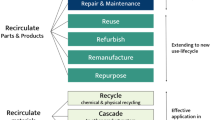Abstract
Root-cause analysis (RCA) is useful in solving inventive problems in any area including manufacturing. It often plays the central role because the root causes revealed can directly imply directions for solutions. This study introduces a new RCA method called cause-effect chain analysis plus (CECA+), improved from the existing method, cause-effect chain analysis (CECA). CECA+ uses a single diagram built and updated in seven steps to manage all the main information of a problem solving process in a systematic and intuitive way. The seven steps are problem definition (1), building and verifying cause-effect chains (2, 3), building and verifying solving direction chains (4, 5), and building and verifying idea chains (6, 7). Based on the theory of solving inventive problems (TRIZ), it can help users to reveal hidden, overlapping or contradictory causes and to generate comprehensive solving directions semi-automatically. It also greatly improved the drawing convenience and readability by using a versatile free diagramming software and a set of intuitive and systematic drawing conventions. CECA+ has been used successfully in many problem solving projects. Application to solving a real problem in manufacturing process was described with tips for using.
Similar content being viewed by others
References
Andersen B, Fagerhaug T (2006) Root cause analysis: simplified tools and techniques. ASQ Quality Press, Milwaukee, pp 5–13
Okes D (2005) Improve your root cause analysis. Manuf Eng 134(3):171–178
Ohno T (1988) Toyota production system: beyond large-scale production. CRC Press, Boca Raton
Graves K, Simmons D, Galley M (2010) Cause-and-effect mapping of critical events. Critical Care Nursing Clinics of North America 22(2):243–251
Litvin S, Axelrod B (1996) The method of constructing causal chains of undesirable effects. Manuscript, Saint-Petersburg: IMITsentr 4c:1996. (in Russian)
Abramov O (2015) TRIZ-based cause and effect chains analysis vs. root cause analysis. TRIZfest-2015:283–291
Zlotin B, Zusman A et al. (1996) Automated problem formulator and solver. United States Patent 5,581,663
Souchkov V (2005) Root conflict analysis (RCA+): structuring and visualization of contradictions. In: Proceedings of ETRIA TRIZ Future Conference
Clifton E (1999) Fault tree analysis—a history. In: Proceedings of the 17th International Systems Safety Conference
Litvin S, Feygenson N, Feygenson O (2011) Advanced function approach. Procedia Eng 9:92–102
Kaplan S, Visnepolschi S, Zlotin B, Zusman A (1999) New tools for failure and risk analysis: anticipatory failure determination (AFD) and the theory of scenario structuring. Ideation International Inc., Farmington Hills
Lenyashin V, Kim HJ (2006) Harmful system: the use of this concept in modern TRIZ. Online Journal Metodolog. https://www.metodolog.ru/00859/00859.html
Gano DL (2007) Apollo root cause analysis—a new way of thinking, Third ed. Apollonian Publications LLC, Kennewick
Katsakiori P, Sakellaropoulos G, Manatakis E (2009) Towards an evaluation of accident investigation methods in terms of their alignment with accident causation models. Safety Sci 47(7):1007–1015
Terninko J, Zusman A, Zlotin B (1998) Systematic innovation: an introduction to TRIZ. CRC Press, Boca Raton, pp 78–89
Funding
The research received support from the TEKES Finnish Funding Agency for Innovation and its Finnish Distinguished Professor (FiDiPro) program.
Author information
Authors and Affiliations
Corresponding author
Additional information
Publisher’s Note
Springer Nature remains neutral with regard to jurisdictional claims in published maps and institutional affiliations.
Rights and permissions
About this article
Cite this article
Lee, MG., Chechurin, L. & Lenyashin, V. Introduction to cause-effect chain analysis plus with an application in solving manufacturing problems. Int J Adv Manuf Technol 99, 2159–2169 (2018). https://doi.org/10.1007/s00170-018-2217-1
Received:
Accepted:
Published:
Issue Date:
DOI: https://doi.org/10.1007/s00170-018-2217-1




